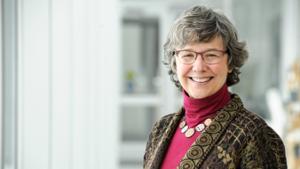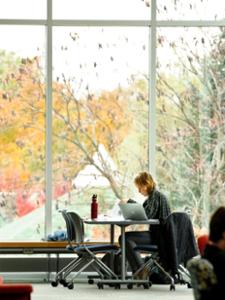
Medieval and Renaissance Studies
The goal of the Medieval and Renaissance Studies Program is to encourage critical understanding of the multicultural histories, literatures, and artistic traditions of the European and Arab-Islamic worlds--and the various forms of exchange, conflict, and contact between them.
About the Minor
In this interdisciplinary program, students delve into the complex histories and cultures of medieval and early modern worlds from a variety of perspectives, taking courses in art, literature, languages, history, and music from Byzantium to Shakespeare’s England. Working closely with faculty in small classes, students find one-on-one encouragement, personal direction, and research opportunities.
A Sampling of Courses

Visual Culture of the Medieval World
This course surveys the art and architecture of Europe during the Middle Ages from ca. 500-1400. We will focus on key artworks and monuments made and built in Europe from the Visigoths and Vikings to the Valois court, as well as examine cross-cultural interactions across religious and political boundaries in medieval Africa, the Arctic, and the Mediterranean. Students will develop an awareness of the production, function, and social context of medieval visual culture through the close study of architecture, manuscript, metalwork, mosaic, painting, sculpture, and textile. Despite our historical distance from the Middle Ages, we will also consider how medieval imagery remains relevant to our current visual world.
Explore these select courses:
Solo vocal and choral music of the Medieval, Renaissance, and Baroque eras from Gregorian chant to Bach. Topics include text expression through music, historical approaches to vocal compositional styles and performance practices (a cappella and accompanied), and responses to early music by later composers (Lauridsen, Whitacre, Respighi, Vaughan Williams, Britten, Orff, Pärt). Some consideration of the use of early music in film and television (Lord of the Rings, Dangerous Liaisons, Shakespeare in Love, The Adventures of Robin Hood, and Game of Thrones).
Beginning in the Age of Encounters and ending with the Enlightenment, the course traces how the Scientific Revolution fundamentally changed the way we think about nature through key figures, including da Vinci, Copernicus, Kepler, Galilei, Bacon, Descartes, Newton, and Linnaeus. In addition to basic concepts and terminology in the history of science, students will read and analyze primary sources; think critically about how historians write history; evaluate the role of institutions and social customs in the creation of knowledge; and articulate historical arguments orally and in writing.
"Amor condusse noi ad una morte" (“Love led us to one death”). As Dante portrayed in the Inferno, the experience love is inseparable from death. Our journey begins with Dante’s memory of Beatrice retold and reimagined in The New Life—a work inspired as much by love as by death. When Dante reunites with Beatrice in The Divine Comedy, his understanding of love also evolved. How did this shift prompt him to twist the stories of great lovers as a near-death encounter? We will explore an array of literary variations on the theme of love and death from the Middle Ages to the contemporary world. In addition to investigating the rich literary tradition, we will also turn to works in music and the visual arts.
Meet Our Faculty
Mackenzie Cooley
Associate Professor of History, Director of Medieval and Renaissance Studies
History of science; early modern world; Colonial Latin America; environmental history; intellectual history; digital humanities; history of gender and sexuality; animal studies; genetics and history
archaeological history of South Asian religions, especially Buddhist and Hindu traditions; research in themes of inter-religious dynamics, syncretism and religious transformation; colonialism and reconfigurations of sacred centers; and religion and water management in the Buddhist and Hindu traditions
social and economic history of the early Middle Ages; history of law and mechanisms of conflict resolution; the perceptions of non-Christian peoples and lands in medieval manuscript culture
Dolly Parton; American folk and traditional musics; banjo, music and film; medieval and renaissance music; music and gender
Old English, Middle English, and Middle Scots language and literature
Margaret Thickstun
Jane D. and Ellis E. Bradford ’45 Distinguished Writing Chair
literature in 17th-century England and Colonial America, particularly by women and by people writing on religious subjects
Medieval and early modern art; Scandinavian studies; German studies; economics and trade; religious iconography; object-based learning; history and methods of art history
Explore Hamilton Stories

Thickstun Presents at Conference on John Bunyan
Margie Thickstun, the Jane D. and Ellis E. Bradford ’45 Distinguished Writing Chair, recently presented a paper during the 11th Triennial Conference on John Bunyan at the University of Prince Edward Island.
Contact
Department Name
Medieval and Renaissance Studies Program
Contact Name
Mackenzie Cooley, Program Director
Clinton, NY 13323












